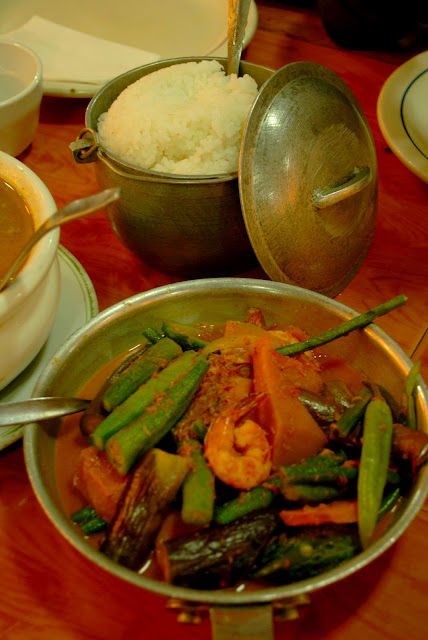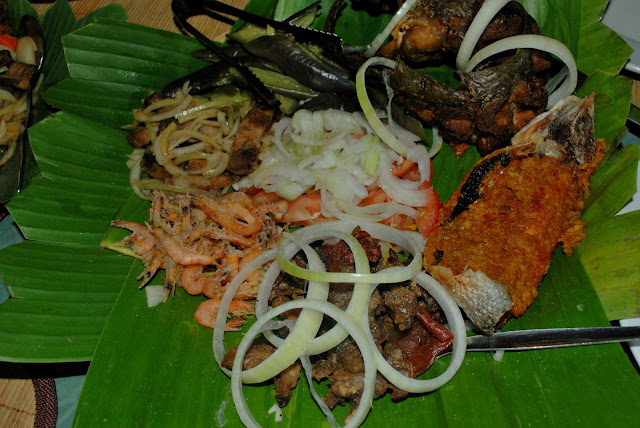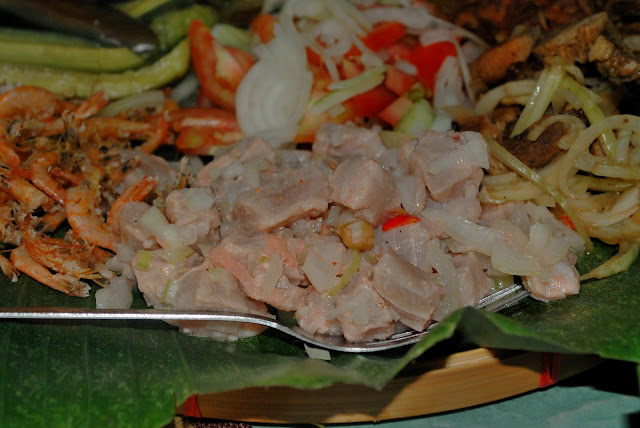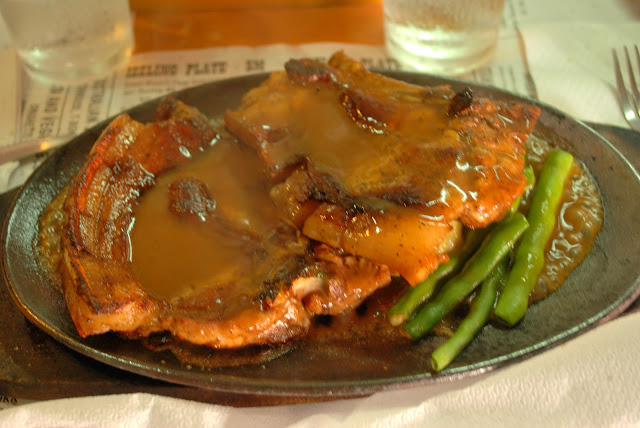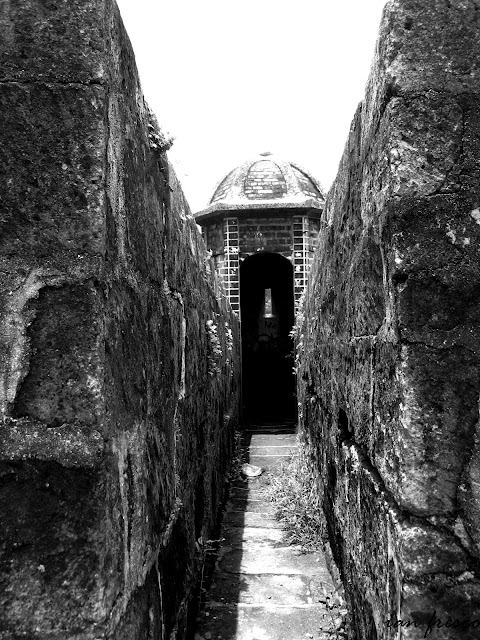Good Job Department of Tourism! The It's more fun in the Philippines campaign is well done. The campaign i think gives a different perspective to both foreign and even locals alike. See for your self on why it's MoreFunInThePhilippines! This one inspires me a lot, so Let's hit the road of Pilipinas!
10.04.2012
It's really #MoreFunSaPilipinas
Good Job Department of Tourism! The It's more fun in the Philippines campaign is well done. The campaign i think gives a different perspective to both foreign and even locals alike. See for your self on why it's MoreFunInThePhilippines! This one inspires me a lot, so Let's hit the road of Pilipinas!
I eat my heart out in the City of Pines!
The Summer Capital of the Philippines do not only offer amazing view and cool temperature among its visitors, it also offers array of everything "Naimas". It doesn't matter if you are vegetarian or if you wanna try to eat in a retro inspired resto name Baguio will serv it fresh in a platter. Here's some resto that we've tried during our stay in Baguio, "Mangan tayon!" (Image above: 50's Diner, Shakes.):
1. Solibao has been consistent since 1972 in serving authentic and fine Filipino food. There are five branches scattered throughout the city, we hit the road to Burnham Park to dine after a long and tiring ride. Here's a primer on why you will skip your diet thing while here in Baguio. :)
Sinigang with Ilocos Bagnet
Solibao's Special Pinakbet
2. 50"s Diner. This is how i describe the restaurant: Inexpensive, BIG SERVINGS, comforting and simple. Located At the corner of Upper General Luna and Brent Roads in Baguio this all American 50's inspired diner with a little pinoy touch will not only delight kids with their shakes but Jukebox, 50's movie posters and others memorabilia's of that time will sure bring smile to the face of young at hearts that will visit and dine here.
"Blast from the past? No, its the interior of 50's Diner."
"Spot the Pinoy touch in this dish?" -----> "Rice!"
Humongous club house its literally "BIG" burrrp! :)
3. Pizza Volante. We had our dinner here, its fun 'coz we did a mash up and a dance number for Pizza Volante in the tune of "Volare by Kings Gipsy" :) Anyways, the restaurant offers pizza, pastas and salads. The food they serve lives up to it's menu discription and the price is very affordable. Pizza Volante is located along Session Road, Baguio City, fronting the side street of leading to Baguio cathedral. "Bon appetit!"
"What i like here is that all ingridients are fresh"
My favorite, Fresh Lettuce top with pomelo, chicken, peanuts and Vinegar dressing.
4. Kubong Sawali. The restaurant serves dishes that are healthy and nutritious that satisfies both local and foreign alike. The restaurant offers authentic and exotic Filipino fused with Ilokano dishes that are rarely done in most of the restaurants in Baguio City.
"Kinilaw na Tuna".
5. Sizzling Plate Baguio. It's a no-brainer, one can really see how Americans influence the city of Pines especially with the food they serve. It was our last meal before heading back to Manila. Yes steaks here are very affordable and they sizzles!
Steak! Steak! Steak! :)Sizzle! Sizzle! Sizzle! :)
Yes! This is the ULTIMATE LECHE FLAN EVER!!! Chocolate Leche Flan by Sizzling Plate.
When you are in Baguio you should not only eat with your mouth but:
with your eyes - you can see how fresh the ingredients are, how consistent they are in their themes.
with your nose - smell the aroma, smell the freshly baked goods.
with your ears - listen to every sizzles and burp of the satisfied tummy.
with your heart- the food being serve here our authentic local dishes and some are influenced by the westerners still with a touch of Filipino.
*Thanks to Mich of Chasing Philippines for the amazing experience!
9.20.2012
BornFree Goes to Binondo
Filipino - Chinese Arch at Binondo.
It was a gloomy afternoon when Mark and i decided to go to Binondo, Manila or commonly known as "China Town" . Its also quite a challenge co'z i only have 500 pesos in my pocket - "kasya kaya to?" :) "Challenge Accepted!" Let's hit the road of Binondo,Manila.
The name "Binondo" is a toponym derived from the archaic spelling of the Tagalog term "binondoc" (modern orthography: binundók), or mountainous, referring to the district's originally hilly terrain. - Source is Wikipedia.
This famous Ongpin Street brings out tons childhood memories.
Minor Basilica of San Lorenzo Ruiz also known as Binondo Church.
The area is one of the center of commerce and trade for all types of goods and businesses run by Filipino-Chinese merchants.
Chow time!!! We ate at Eng Bee Tin i ordered the Wanton Noodle Soup. Yummm! :)
And Mark's Pork Asado Noodle Soup...
And a refreshing Winter Melon Tea or "Kundol" in tagalog.
Just a thought: Since time immemorial our forefathers and these Chinese trade, live and eventually became a part of our everyday lives in this little town of Binondo. Recently, we have some conflict with China over disputed Islands in the West Philippine sea. Can we just co- exist, look back and maybe consider the strong bond as a Filipino - Chinese? Even though we are very different in terms Culture and Tradition, yet i think we should live harmony.
8.08.2012
BornFree Hits the Road of Taal, Batangas!
Last July 29, 2012 typhoon "Gener" did not stop me to hit the road, this time i'm heading to the Heritage Town of Taal, Batangas. (actually sa Talumpok Falls sana kami pupunta sa Sico, Batangas, kaso bumabagyo so di na talaga sya natuloy.) Thanks to Alona for letting me stay in their house, i thought that i cannot even go to Taal that day because of the heavy downpour. I did not really have that chance to check the whole town but instead we head our way to the Basilica de San martin de Tours. It is considered to be the largest church in the country and in Asia.
Facade of the Basilica de San martin de Tours resembles that of St. Peter's Basilica in Rome.
National Historical Commission's marker on the Cathedral.
The basilica sits on top of the hill overlooking the heritage town of Taal.
The main Altar of the Cathedral, the Tabernacle is made of silver, its one of a kind in the Philippines.
On the left side is just one of the small altars that houses "santo's" inside the Cathedral, while on the left part of the picture is a "pupito" or pulpit which is use to deliver sermon or homily during mass.
Interior of the Basilica: facing the main altar the back part is the choir loft. The lights and the hand paint details details is just amazing!
Elaborate paintings and details inside the Basilica.
Confessional box.
"Carroza" which is use during Holy Week and Fiesta.
Restored "Escuela Pia" now a Taals, Cultural Center is just a few steps away in front of the basilica. The image below is the Municipal Hall of Taal. It depicts the usual set up during the Spanish era, wherein the church , school and the seat of government is just in one area.
There is more to explore in Taal, i did not have the chance to visit the Agoncillo Museum, the Shrine of Our Lady of Caysasay, the famous "Balisong" of Batangas, the public market that sells "Tapang Taal". I can't wait to go back and hit the road again of the Heritage Town of Taal, Batangas.
How to get there: From Manila, take the bus bound to Lemery, Batangas then tell the driver to drop you off to the Taal Basilica. (by the way usually buses don't) so you can also get off to Palanas (which is the last stop) then you can take a trycle back to the Basilica.
7.18.2012
BornFree Hits the Road of Intramuros
It was a boring Sunday for me so i decided to go and hit the road of Intramuros, Manila. Damn it was hot and humid but it did not stop me to walk and walk and walk and take pictures of the old city. Intramuros was the seat of government during the Spanish Colonial Period. The name Intramuros derived from a Latin word which means "within the walls" thus the district outside the wall were referred to as Extramuros which means "outside the walls".
At the end of World War II, all of the structures in Intramuros were destroyed by both the Japanese Imperial Forces and U.S Air Force. Of all the churches, government buildings, schools and residences, only one structure, the Church of San Agustin survived the heavy bombardment but not without any damage.
The present day structures inside the walled City was restored by then President Ferdinand E. Marcos in 1951 when it was declared as a national shrine.
"Its my first time to have a photo walk alone, yes i'm nervous co'z i don't know what to expect but i enjoyed it, most of the pictures that i will be posting are in grayscale or in sepia to really capture beauty of Old Manila."
Before hitting the road, just a simple reminder :)
A view of Manila City Hall "Clock Tower".
Puerta del Parian
"sentry station" or tower
"laryo" or bricks detail of the ceiling in one of the chambers.
The "Memorare" this monument remembers all the innocent people who died during the Liberation of Manila.
The Manila Cathedral also known as The Basilica of the Immaculate Conception.
The San Agustin Church was constructed during the Spanish colonial period, it is listed as UNESCO's World Heritage Site.
The facade of San Agustin Church shows the rich Chinese influence of the structure.
Ornate doors of San Agustin Church.
"Habang naglalakad, ako'y napapa-isip, kung makakapag salita ang mga pinto, ang mga pader, bintana, eskinita at pasilyo ng Intramuros ano kaya ang kanyang sasabihin ano kaya ang kanyang e kukwento sa akin? Siguro'y tungkol sa mga dayuhang tsino, espanyol o americano, o dili kaya'y tungkol sa mga nag -daang digmaan, sa mga indio at mga mestizo, sa mga binibini at mga solterong tumatakas sa kanilang mga magulang para mag-kita, o mga prayle na kamukha ni Padre Damaso. Siguro isa sa mga nilalakaran ko ngayon ay nilalakaran ni Dr. Jose Rizal. Isa sa mga gusaling ito ay ginanap ang mga engrandeng piging ng mga mayayaman sa lugar, siguro ito ay saksi sa mga pang aapi, kurapsyon, pag paslang ng mga inosente at walang sala sa pagpupulong sa isang pag aaklas o himagsikan, sa pag hahayag ng kalayaan... o kaya's mga liihim na di na kailangang e hayag o dapat nalang manatiling lihim pang habang buhay".
"Kung makakapag salita sila ano kaya sa tingin mo ang kanilang e kukuwento at sasabihin sayo?"
Subscribe to:
Posts (Atom)



